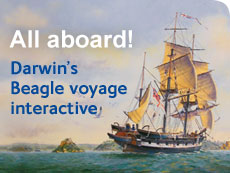Charles Darwin
Charles Darwin transformed the way we understand the natural world with his revolutionary ideas. But why wasn’t everyone convinced?
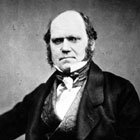
Charles Robert Darwin (1809-1882).
The classic English country gentleman, Darwin seems an unlikely figure to create a controversy. He had developed a radical theory that brought him into conflict with a very traditional establishment – the Anglican Church. History has vindicated him and he is now celebrated as one of the greatest and most innovative scientists who ever lived. But, Alfred Russel Wallace, who hit upon the theory at the same time, has not received similar recognition.
To this day, Darwin’s theory of evolution by natural selection is widely accepted, and explains the distant origins and fantastic variety of life on Earth.
Video
Museum curator George Beccaloni introduces us to Charles Darwin, the most famous biologist in history, in this video. He talks about the collecting expedition that helped Darwin formulate the theory of evolution by natural selection and shows us some of the specimens from that voyage.
For more detail about Darwin’s life read the Work and Timeline sections. Here you’ll find out more about Darwin’s theory, which he co-discovered with Alfred Russel Wallace.
You need Adobe Flash Player, or an HTML5 enabled web browser, and JavaScript enabled to watch this video.
Visit the Adobe website to download the latest Adobe Flash Player
Work
The young naturalist
Born in 1809, Darwin was fascinated by all living things from a young age. While growing up he was an avid reader of nature books and devoted his spare time to exploring the fields around his home, collecting plants and insects.
In 1825 he became a medical student at the University of Edinburgh but was so traumatised by an operation performed on a child without anaesthetic that he gave up his studies without completing the course. He then went to Cambridge University to study theology. Darwin graduated four years later, but was in no hurry to take holy orders. Instead, he set off on a journey that was to change his life, and much more besides.
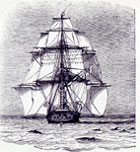
Drawing of HMS Beagle from 'A Naturalist's Voyage Round the World' 1912 by Charles Darwin
In 1831 Darwin embarked on a five year voyage aboard the Beagle. The ship sailed to South America to carry out surveying work. Darwin, who had been recommended by one of his Cambridge professors, had a joint role as naturalist and companion to the ship’s captain, Robert FitzRoy.
Darwin explored remote regions and marvelled at a world so different from the one he knew. He encountered birds with bright blue feet, sharks with T-shaped heads and oversized tortoises.
Everywhere he went, Darwin amassed plants, animals and fossils, and took copious notes. These collections and records were to provide the clues he needed to develop his remarkable theory.
The theory of natural selection
Darwin returned to England in 1836. A methodical and industrious scholar, he spent years analysing his specimens.
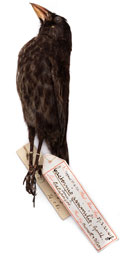
Cactus finch found in the Galapagos Islands, collected during the Voyage of the Beagle.
Darwin realised that evolution occurs by the process of natural selection. The ‘fittest’ animals or plants – those with the characteristics best suited to their environment – are more likely to survive and reproduce. They pass on these desirable characteristics to their offspring. Gradually those features become more common, causing the species to change over time. If the changes are great enough, they could produce a new species altogether.
Darwin had collected some finches from the Galápagos Islands, which helped him to formulate his idea. Some had stout beaks for eating seeds, others were insect specialists. Darwin realised that they were descendents of a single ancestor. As they dispersed to different islands, the birds had adapted to eat the various foods available. Natural selection had produced 13 different species.
A joint announcement
Darwin knew his radical ideas would meet with stiff opposition. He delayed publishing them for many years while he assembled a mountain of evidence. He sought the advice of Cambridge professors, pig breeders and pigeon fanciers.
During this time, Darwin learnt that Alfred Russel Wallace, a young naturalist, had developed similar ideas to his own. Scrupulously honest, Darwin volunteered to send Wallace’s ideas to a journal for immediate publication. However, his friends advised that the fairest solution would be a joint announcement.
The following year saw the publication of Darwin’s contentious, celebrated book, The Origin of Species.
Evolution versus Creation
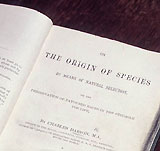
Title Page of 'On The Origin of Species by means of natural selection' by Charles Darwin, 1859
The Origin of Species was published in 1859. It provoked outrage from some members of the Church of England as it implicitly contradicted the belief in divine creation. Darwin's opponents accused him of blasphemy but their efforts were in vain - the book was already becoming a bestseller.
The Descent of Man, published in 1871, aroused even greater debate since it suggested that humans descended from apes. The vexed Bishop of Oxford famously asked Thomas Huxley, one of Darwin’s most enthusiastic supporters, whether it was through his grandfather or grandmother that he claimed descent from a monkey. Despite the attacks, Darwin’s conviction in scientific theory remained unshaken.
Darwin’s legacy
Although Darwin’s theory has been modified over time, it remains fundamental to the study of life sciences. But the controversy still exists.
There are some who don't agree with Darwin's theory being taught in school biology classes. However the theory of evolution is accepted by the scientific community as the best, evidence-based explanation for the diversity and complexity of life on Earth.
Darwin changed not only the way we see plants and animals, but also the way we see ourselves.
The animals and plants he collected form part of our national heritage and many are held at the Museum.
Timeline
| 1809 | Born 12 February in Shrewsbury, Shropshire, England. |
|---|---|
| 1815 | Napoleon defeated at the Battle of Waterloo. |
| 1825 | Enrols at the University of Edinburgh to study medicine, but finds he is not suited to it. |
| 1828 | Enrols at Cambridge University to study theology, but is more enthusiastic about collecting beetles. |
| 1830 | Charles Lyell publishes The Principles of Geology , proposing a vast timescale for Earth's history. |
| 1831-36 | Voyage of HMS Beagle. |
| 1833 | Slavery is abolished in the British Empire. |
| 1836 | Darwin returns to London and starts work on his collection of specimens. |
| 1837 | Victoria becomes queen. |
| 1839 | Darwin marries Emma Wedgwood, his cousin. |
| 1842 | Darwin and Emma move to Downe, Kent, England, where they will live for the rest of their lives. |
| 1858 | Both Darwin's and Wallace's ideas presented to the Linnean Society. Response is muted. |
| 1859 | Publication of The Origin of Species provokes great controversy. |
| 1865 | Publication of Mendel's experiments on heredity |
| 1871 | Publication of The Descent of Man shocks Darwin's opponents. |
| 1882 | Dies 19 April in Downe. Darwin was given a state funeral and buried in Westminster Abbey. |
